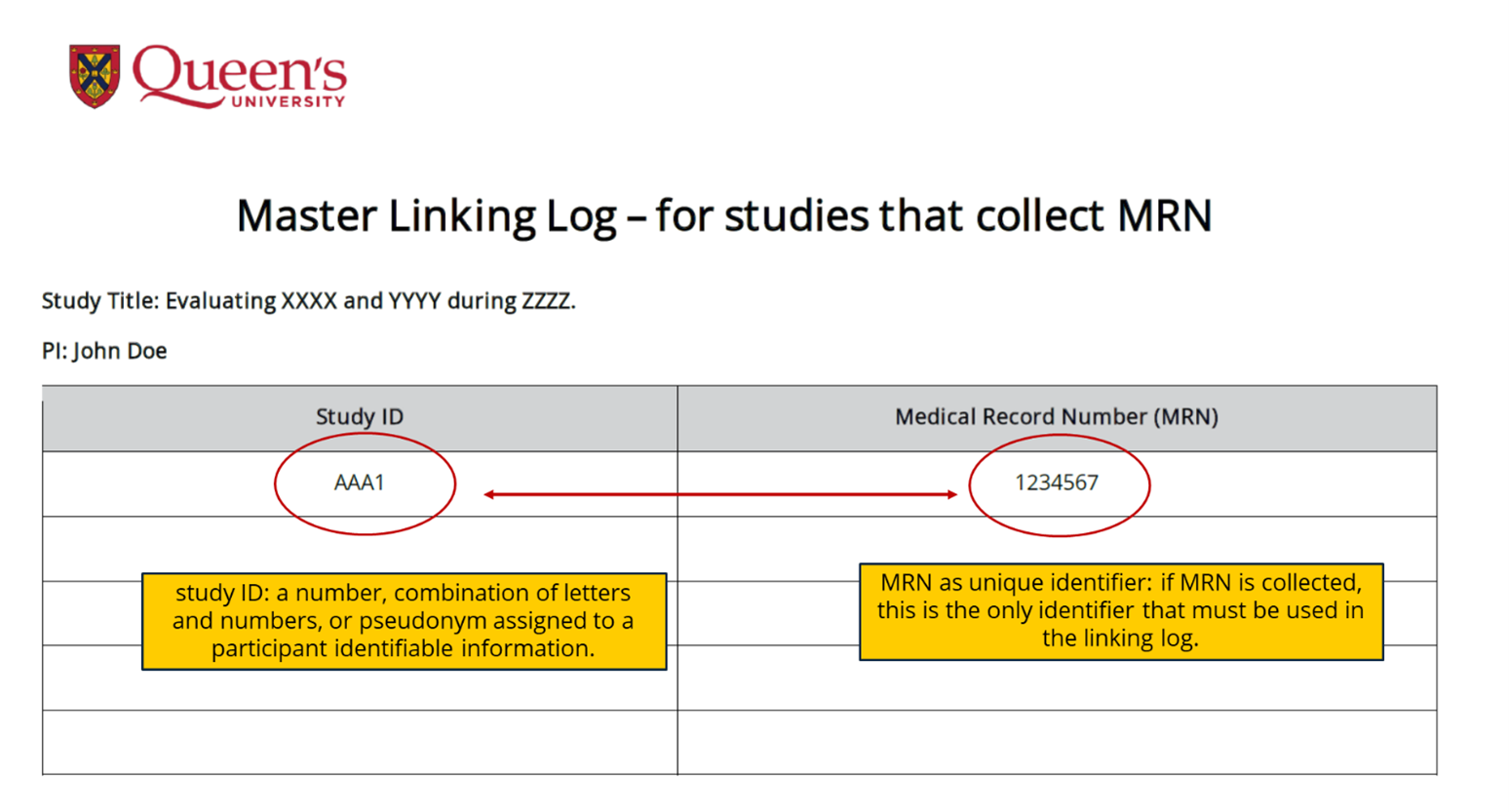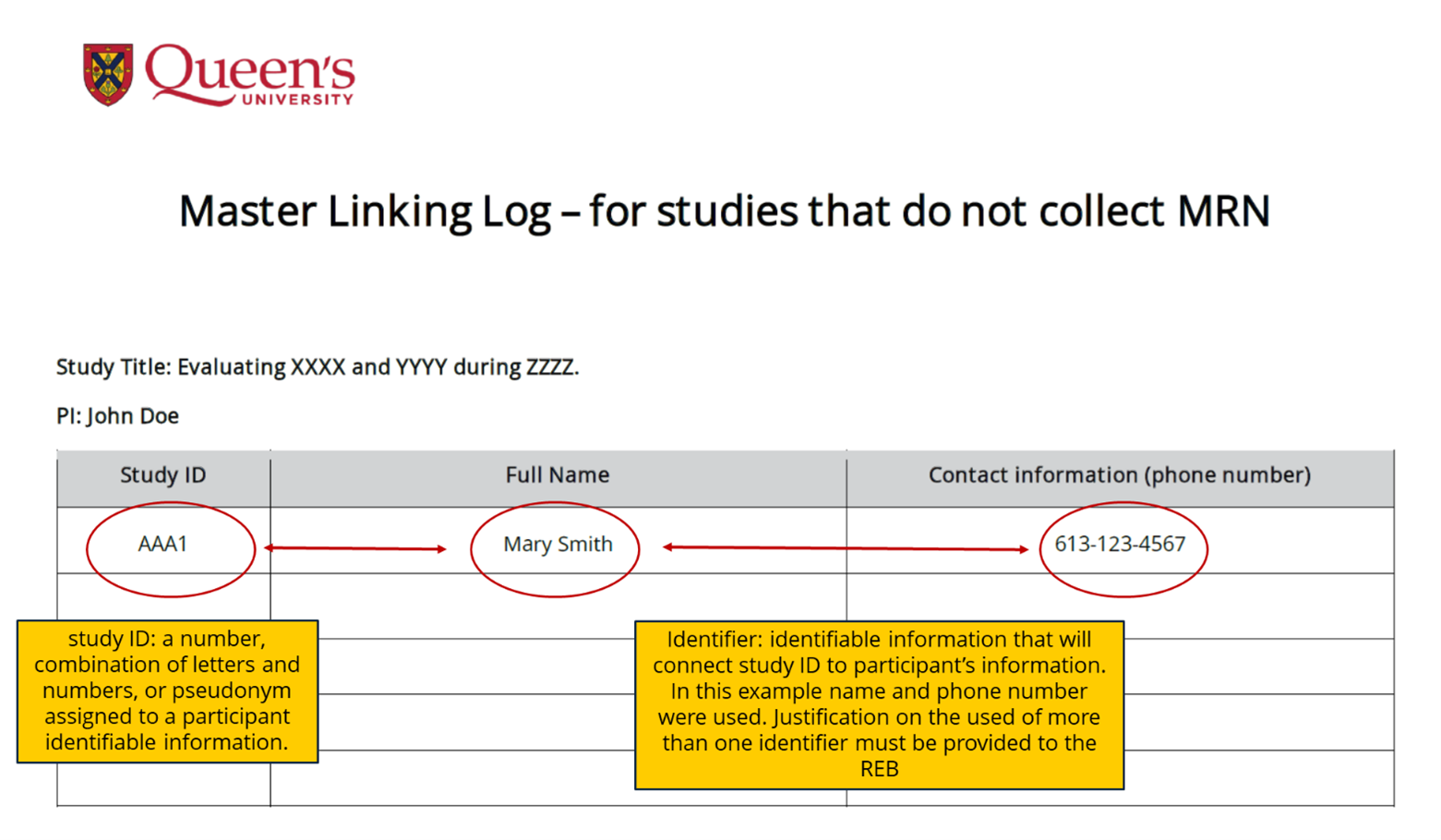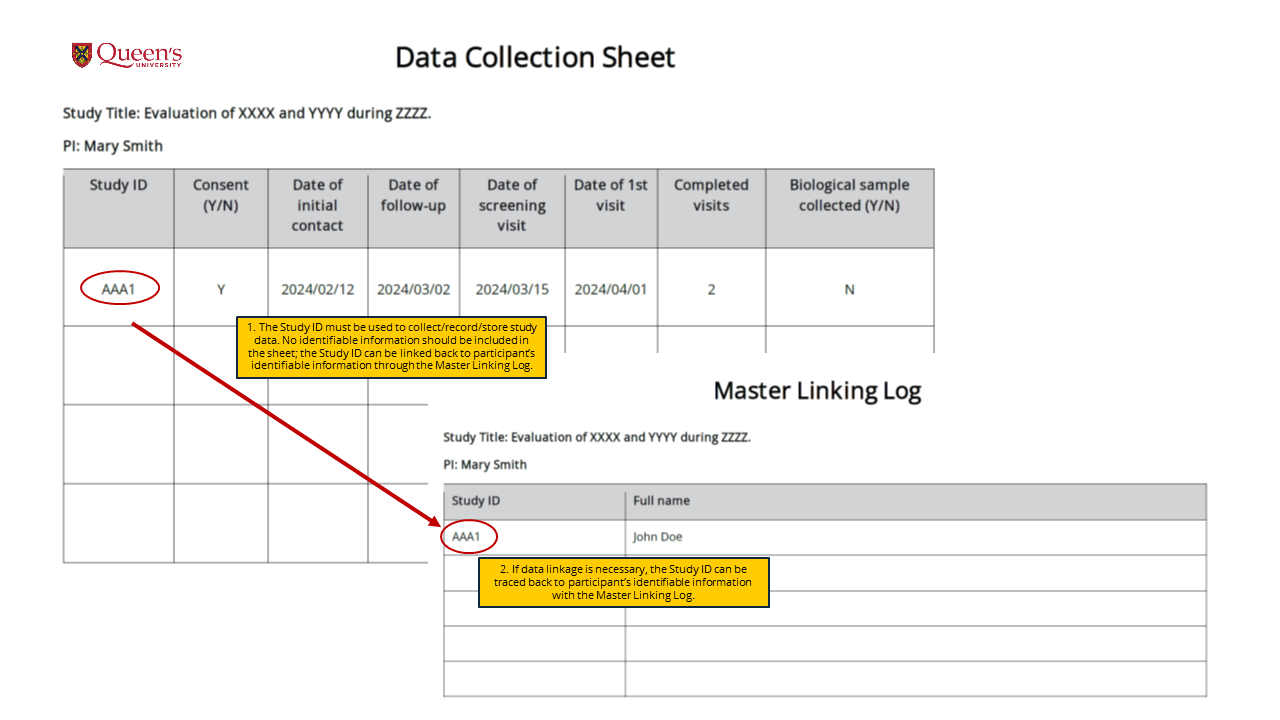Version: 2.0
Date: April 8, 2024
This publication is protected by copyright and can be used in accordance with the Creative Commons CC BY-NC-SA license. This license permits distributing, remixing, adapting, and building upon the material in any medium in any format for non-commercial purposes only as long as attribution is given to Queen’s University. If the material is remixed, adapted, or built upon, the resulting material must be licensed in accordance with the Creative Commons CC By-NC-SA license or under identical terms.
Inquiries and permission requests for commercial use may be directed to:
Queen’s University
Vice-Principal Research
Research, Compliance, Training, and Ethics
chair.greb@queensu.ca, hsreb@queensu.ca
Research Compliance, Training and Ethics
Contents
Purpose
The purpose of this guideline is to:
- Provide clear guidance on the use of master linking logs and participant information logs for research purposes.
- Promote and facilitate best practices for the use of master linking logs and participant information logs.
Background
The Principal Investigator (PI) is responsible for ensuring data and privacy protection. This includes both physical (physical location and equipment) and electronic (access control and passwords) security of research data. The master linking log is used as a centralized record-keeping system that helps manage and track participants enrolled in a research study.
The master linking log and data collection sheets complementary each other. Each document
contains information that when used on its own is relatively low risk; however, when put together they can identify the participant.
Master Linking Log Guidelines
The master linking log is a document that links a unique study ID with identifying information of the participant. The study ID can be a unique number, unique combination of letters, numbers and/or symbols, or a pseudonym used to identify a research participant. The assignment of a study ID to a participant is considered best practice for privacy purposes and must be used to collect/record/store study data pertaining to a participant. The master linking log should only be used when data linkage is necessary (e.g., when participant requests withdrawal from a study and study team needs to link their personal information with study ID to remove data).
Access to the master linking log must be restricted to designated research personnel and must not leave Queen’s University and/or its affiliated hospitals or be shared with anyone besides authorized research team members.
The master linking log is subject to the highest level of security as the participant has been promised that their identity will be confidential. Whoever who gains access to the master list can link the participant directly to the responses/data or information they have provided.
| Note: |
|---|
| Master linking logs should be protected behind administrative, physical and/or electronic safeguards. For example, the master linking log should be housed on the Queen’s server (electronic safeguard), and accessed on a laptop that has a password (electronic safeguard) and the laptop is stored in a locked office (physical safeguard) in a locked filing cabinet (physical safeguard). |
Key Information Included in a Master Linking Log
Key information that must be present in the Master Linking Log includes:
- Study title and PI information.
- Study ID: A unique code assigned to each enrolled participant. This code is used consistently throughout the study to avoid confusion and ensure data accuracy.
- Version date of the document and page number (located in the footer).
- Direct participant’s identifier: A piece of identifiable information for the participant enrolled in the study, linked to the unique code (e.g., full name, date of birth (DOB) or Email address). If more than one unique identifier is required on the master linking log, then justification needs to be provided to the REB for each additional identifier.
Master Linking Logs using Medical Record Number as identifier
The Medical Record Number (MRN) is used by health organizations to identify an individual, medical record/information and provides access to their contact information. If MRN is collected for your study, identifiers such as telephone number or email address are not required on the master linking log, since this information is available through the MRN. The linking log must only contain MRN as unique identifier (no other information should be added to the log) in addition to study ID.
If the researcher would like more than the MRN listed on the master linking log then, each identifier added to the master linking log must be strongly justified to the REB. The REB will not approve master linking logs with the MRN and additional contact information for convenience purposes. The onus is on the researcher to justify to the REB the use of more than one identifier.

study ID: a number, combination of letters and numbers, or pseudonym assigned to a participant identifiable information.
Right box reads:
MRN as unique identifier: if MRN is collected, this is the only identifier that must be used in the linking log.
Master Linking Logs NOT using Medical Record Number as identifier
Master Linking Logs that do not use MRN as the identifier (i.e. for some health care related studies where no access to medical information is necessary, or studies submitted to GREB) the master linking log might contain more than 1 identifier (example, collection of full name AND phone number for contact purposes). However, each identifier added to the master linking log must be justified to the REB. The onus is on the researcher to justify to the REB the use of more than one identifier.

Study Id: a number, combination of letters and numbers, or pseudonym assigned to a participant identifiable information.
Right box reads:
Identifier: identifiable information that will connect study ID to participant’s information. In this example name and phone number were used. Justification on the used of more than one identifier must be provided to the REB.
Data Collection Sheet guidelines
Data collection sheets are used as a record keeping tool during the study to track participant’s collected data. Participant’s study data must be entered using the unique study ID (assigned in the master linking log – see above) and no other identifiable information should be included. If data linkage is necessary, the study ID can be used to link data back to participant’s identifiable information through the master linking log.
Key information included in data collection sheet
Key information that should be present in the data collection sheet includes:
- Study ID: A unique code assigned to each enrolled participant. This code is used consistently throughout the study to avoid confusion and ensure data accuracy. The code can be linked back to participants’ identifiable information through the Master Linking Log.
- Other information that might be present in the data collection sheet includes:
- Study-Specific Information: Details related to the specific study in which the participant is enrolled. This may include study site, enrollment date, and study arm/group assignment.
- Consent: Documentation of the participant's informed consent to participate in the study and evidence of ethical and regulatory approvals obtained for the study.
- Visit and Assessment Schedule: Timetable for participant visits, assessments, tests, and interventions as outlined in the study protocol.
- Status Updates: Updates on the participant's progress within the study, including completed visits, missed appointments, discontinuations, withdrawals, or completion of the study.
- Participant’s Contact/Follow-up: Plans for contact or follow-up activities during the study.
- Other relevant study information (as applicable).
| Note to researcher: |
|---|
| do not use any identifiable information on the data collection sheets; only study IDs must be used. Data can be linked back to identifiable information through the master linking log. |
How to use the Master Linking Log and Data Collection sheets
Part 1.
When a participant is enrolled in the study, assign a unique Study ID to them, and include one piece of identifiable information that will be used for the master linking log.
Two examples are provided below; note (as indicated by the arrows) that you can link back any study information recorded with study ID to each individual participant through the use of the Master Linking Log:
Example A:
In this scenario, MRN is used as unique identifier for participant, and a combination of letters and numbers was used as study ID. As noted above, the MRN provides access to the participant contact information, therefore this information should not be included in the linking log.

study ID: a number, combination of letters and numbers, or pseudonym assigned to a participant identifiable information.
Right box reads:
MRN as unique identifier: if MRN is collected, this is the only identifier that must be used in the linking log.
Example B.
In this scenario, no MRN is collected, thus access to contact information is not possible through medical records. In this case, a unique identifier (full name) is stored in the master linking log along with phone number, for contact purposes. Phone numbers can be considered identifiable information, and justification must be provided to the REB.

Study Id: a number, combination of letters and numbers, or pseudonym assigned to a participant identifiable information.
Right box reads:
Identifier: identifiable information that will connect study ID to participant’s information. In this example name and phone number were used. Justification on the used of more than one identifier must be provided to the REB.
Part 2.
After Study ID has been assigned to participant, linked to unique identifiable information, all the study data (contact information, number of visits, study procedures performed, study data such as age, gender, sex, etc.) can be recorded in the Data Collection Sheets. Data should only be recorded and stored using the Study ID assigned to the participant. If data linkage is necessary, the master linking log can be used to link back Study ID to individual participant. In the example below, the master linking log contains only one identifier (full name) linked to study ID.

1. The Study ID must be used to collect/record/store study data. No identifiable information should be included in the sheet; the Study ID can be linked back to participant’s identifiable information through the Master Linking Log.
Right box reads:
2. If data linkage is necessary, the Study ID can be traced back to participant’s identifiable information with the Master Linking Log.